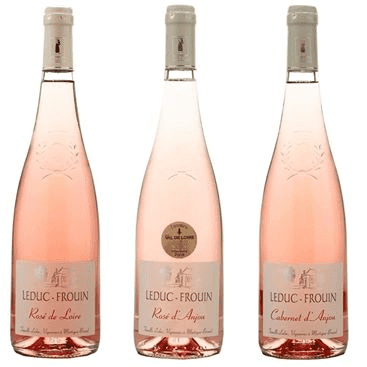
The launch of Domaine Leduc-Frouin’s new website (www.leduc-frouin.com) prompted another look at Loire pinks, an area which I have always found confusing. Antoine Leduc produces some excellent rosés, and I have been a recent convert to the pink stuff. The more that rosés are understood as variants on red wines, rather than blends of red and white, their potential for complexity and finesse become evident. And, neither are they the afterthought or lesser quality juices from the production of red wine – indeed they are sometimes the first gentle pressing of the red grapes, or are processed quite separately. The secret is to ensure that the grape juice (usually white) only spends a short time in contact with the crushed grape skins, which impart colour and tannin to the wine. So often you may seem subtitles like “Vin d’une nuit” indicating that they have only had skin contact at cool temperatures overnight. In some ways more skill is required to make a good rosé than straightforward reds or whites.
The Loire was of course best known in the UK for producing some pretty ghastly sweet insipid rosé wines, before our tastes were educated and we became more demanding of good quality – and Loire rosés like Mateus rosé and Hirondelle passed into our wine tasting adolescence.
However, given time things change and improve – the only thing that does not always help is the French appellation system which offers 3 different generic appellations (excluding more specific ones like Chinon rosé) – i.e Rosé de Loire, Rosé d’Anjou and Cabernet d’Anjou AC
Rosé d’Anjou is made in the area north and south of Angers (59 Maine-et-Loire, Pays de Loire) and can be made from Grolleau, Cabernet Franc, Cabernet Sauvignon, Côt (malbec), Gamay and Pineau d’Aunis. However it can be made as a dry or sweet wine, still or sparkling with secondary fermentation – useful!
Rosé de Loire on the otherhand can be made across a wide area of the Loire Valley including Anjou, Saumur and Touraine, grapes including Cabernet Franc, Cabernet Sauvignon, Gamay, Grolleau, Pineau d’Aunis and Pinot.However, it is specified as a still dry wine.
Cabernet d’Anjou is perhaps the most defined, coming from the area north and south of Angers and made only from Cabernet Franc and Cabernet Sauvignon – and it is always a sweet still wine.
Although there is some administrative logic behind these classifications, they do not really help the consumer very much when hunting for a bottle off the wine merchant’s shelves!
Domaine Leduc-Frouin’s Cabernet d’Anjou is a definite recommendation – despite the fact that it is sweetish. The secret is not to approach the wine with any prejudice – the nose is stunning, full of wonderful summer fruit character, the colour of the wine in the glass seems to be multi-layered hues of pink, and in the mouth the real complexity of the wine with its delicate intermingling of fruit and perfume is quite captivating – followed by a touch of fruit sweetness on the finish.
see our Top 30 vineyard B&Bs in France
find cheap flights and plane tickets from Booking.com
somewhere to stay, a ferry, a train or car hire?
stay on a French vineyard – over 250 vineyards featured across France – hotels, B&B, self-catering ![]()

Discover more from FrenchDuck.com
Subscribe to get the latest posts sent to your email.


